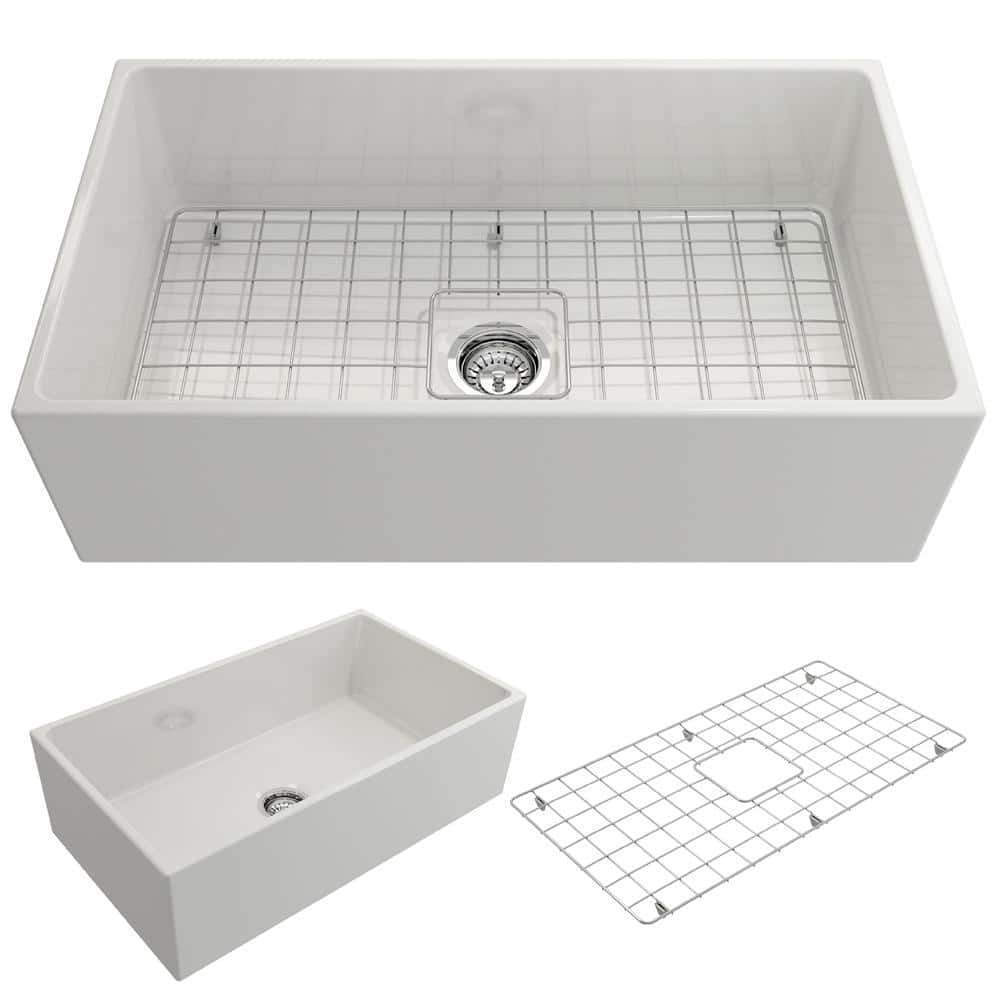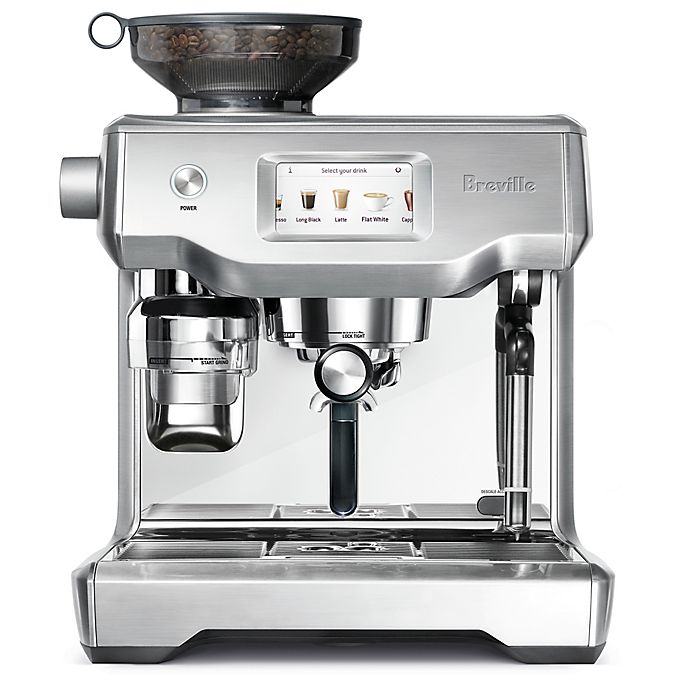BOCCHI Contempo Farmhouse Apron Front Fireclay 33 in. Single Bowl Kitchen Sink with Bottom Grid and Strainer in White
Non-porous fireclay washes away small waste particles. Accommodates hot utensils up to 2000 F without taking damage. Removable grid allows convenient rinsing of utensils.
BOCCHI Farmhouse Sinks bring back the ultimate material to your kitchen. Fireclay, a 100% natural organic and recyclable material used by craftsman for centuries to create timeless appliances has now returned to your kitchen. With the firing in our kilns up to 2000°F temperatures, Fireclay becomes the most durable material used in today’s kitchens. Thus, dealing with extreme heat coming from pots and pans is definitely not a problem. Due to their special glaze coating fused with the fireclay body, our sinks have a non-porous, uniform, scratch and stain resistant surface. With its protective bottom grid and distinctive looks, BOCCHI Farmhouse Sinks are truly crafted to match your design and functional desires.
- Exclusive high-pressure casted fine fireclay production for durability and timeless elegance
- Distinctive apron front installation with reversible application – sink is finished on all four sides
- Extreme resistance to chip, discoloration, scratching and cracking
- 100% non-porous surface provides unmatched stain resistance compared to matte stone or other composite materials
- Includes removable wire mesh bottom grid and strainer
- We do not recommend cutting the countertop until you receive the sink – sizes may vary slightly
- Sink can accommodate a garbage disposal
- Flange extension not needed
Additional information
| Actual Left to Right Length (In.) | 33 |
|---|---|
| Bowl Below Counter Depth (in.) | 10 |
| Bowl Front to Back Width (in.) | 17.5 |
| Bowl Left to Right Length (in.) | 31.5 |
| Bowl Top to Bottom Depth (in.) | 10 |
| Cut-Out Below Counter Depth (in.) | 10 |
| Cut-Out Depth (in.) | 17.5 |
| Cut-Out Width (in.) | 31.5 |
| Kitchen Sink Front to Back Width (In.) | 19 |
| Panel Height (in.) | 10 |
| Panel Width (in.) | 33 |
| Certifications and Listings | ASTM Compliant,CSA Listed,IAPMO Certified |
| Manufacturer Warranty | Limited Lifetime |
An apron is a garment that is worn over other clothing to cover the front of the body. They may have several purposes, typically as a functional accessory that protects clothes and skin from stains and marks. However, other types of aprons may be worn as a decoration, for hygienic reasons, as part of a uniform, or as protection from certain dangers such as acid, allergens or excessive heat. It can also be used at work stations to hold extra tools and pieces or protect from dust and unwanted materials.
As a top layer that covers the front body, the apron is also worn as a uniform, adornment, ceremonial garb (e.g. Masonic apron) or fashion statement. Apron styles can be practical, fashionable, and sentimental.
The word comes from Old French napron, meaning a small piece of cloth. Over time "a napron" became "an apron" through a linguistic process called rebracketing.
A bowl is a typically round dish or container generally used for preparing, serving, storing, or consuming food. The interior of a bowl is characteristically shaped like a spherical cap, with the edges and the bottom forming a seamless curve. This makes bowls especially suited for holding liquids and loose food, as the contents of the bowl are naturally concentrated in its center by the force of gravity. The exterior of a bowl is most often round, but can be of any shape, including rectangular.
The size of bowls varies from small bowls used to hold a single serving of food to large bowls, such as punch bowls or salad bowls, that are often used to hold or store more than one portion of food. There is some overlap between bowls, cups, and plates. Very small bowls, such as the tea bowl, are often called cups, while plates with especially deep wells are often called bowls.
In many cultures, bowls are the most common kind of vessel used for serving and eating food. Historically, small bowls were also used for serving both tea and alcoholic drinks. In Western culture plates and cups are more commonly used.
Contempo can refer to:
- Contempo: A Review of Books and Personalities
- Fender Contempo Organ
- University of Chicago Contemporary Chamber Players
- Contempo Casuals, a former women's clothing retailer that was acquired by Wet Seal
- Contempo (band), the former band of Richard Archer from Hard-Fi
A farmhouse is a building that serves as the primary quarters in a rural or agricultural setting. Historically, farmhouses were often combined with space for animals called a housebarn. Other farmhouses may be connected to one or more barns, built to form a courtyard, or with each farm building separate from each other.
A kitchen is a room or part of a room used for cooking and food preparation in a dwelling or in a commercial establishment. A modern middle-class residential kitchen is typically equipped with a stove, a sink with hot and cold running water, a refrigerator, and worktops and kitchen cabinets arranged according to a modular design. Many households have a microwave oven, a dishwasher, and other electric appliances. The main functions of a kitchen are to store, prepare and cook food (and to complete related tasks such as dishwashing). The room or area may also be used for dining (or small meals such as breakfast), entertaining and laundry. The design and construction of kitchens is a huge market all over the world.
Commercial kitchens are found in restaurants, cafeterias, hotels, hospitals, educational and workplace facilities, army barracks, and similar establishments. These kitchens are generally larger and equipped with bigger and more heavy-duty equipment than a residential kitchen. For example, a large restaurant may have a huge walk-in refrigerator and a large commercial dishwasher machine. In some instances, commercial kitchen equipment such as commercial sinks is used in household settings as it offers ease of use for food preparation and high durability.
In developed countries, commercial kitchens are generally subject to public health laws. They are inspected periodically by public-health officials, and forced to close if they do not meet hygienic requirements mandated by law.
A sink is a bowl-shaped plumbing fixture for washing hands (also known as washbasin in the UK), dishwashing, and other purposes. Sinks have a tap (faucet) that supplies hot and cold water and may include a spray feature to be used for faster rinsing. They also include a drain to remove used water; this drain may itself include a strainer and/or shut-off device and an overflow-prevention device. Sinks may also have an integrated soap dispenser. Many sinks, especially in kitchens, are installed adjacent to or inside a counter.
When a sink becomes clogged, a person will often resort to using a chemical drain cleaner or a plunger, though most professional plumbers will remove the clog with a drain auger (often called a "plumber's snake").
White is the lightest color and is achromatic (having no chroma). It is the color of objects such as snow, chalk, and milk, and is the opposite of black. White objects fully reflect and scatter all the visible wavelengths of light. White on television and computer screens is created by a mixture of red, blue, and green light. The color white can be given with white pigments, especially titanium dioxide.
In ancient Egypt and ancient Rome, priestesses wore white as a symbol of purity, and Romans wore white togas as symbols of citizenship. In the Middle Ages and Renaissance a white unicorn symbolized chastity, and a white lamb sacrifice and purity. It was the royal color of the kings of France as well as the flag of monachist France from 1815 to 1830, and of the monarchist movement that opposed the Bolsheviks during the Russian Civil War (1917–1922). Greek temples and Roman temples were faced with white marble, and beginning in the 18th century, with the advent of neoclassical architecture, white became the most common color of new churches, capitols, and other government buildings, especially in the United States. It was also widely used in 20th century modern architecture as a symbol of modernity and simplicity.
According to surveys in Europe and the United States, white is the color most often associated with perfection, the good, honesty, cleanliness, the beginning, the new, neutrality, and exactitude. White is an important color for almost all world religions. The pope, the head of the Roman Catholic Church, has worn white since 1566, as a symbol of purity and sacrifice. In Islam, and in the Shinto religion of Japan, it is worn by pilgrims. In Western cultures and in Japan, white is the most common color for wedding dresses, symbolizing purity and virginity. In many Asian cultures, white is also the color of mourning.
With or WITH may refer to:
- With, a preposition in English
- Carl Johannes With (1877–1923), Danish doctor and arachnologist
- With (character), a character in D. N. Angel
- With (novel), a novel by Donald Harrington
- With (album), a 2014 album by TVXQ
- With (EP), a 2021 EP by Nam Woo-hyun






by Mike
Nice & deep, smooth service. Just newly installed, so not able to comment on the wear of it yet.
by Steve
I really love the look and feel of this sink. It looks amazing in my recently updated kitchen. The only drawback is that it doesn’t slope enough to drain efficiently.
by Chris
The sink is durable and well made. I would recommend it!
by Louis
Beautiful sink. Extra large size of that’s what you are looking for.
by Thomas
We love it! This is the second one that we purchased. The first was for an outside kitchen and this one was for our laundry room. Both fit perfectly, are functional and look great.
by Kim
Shipped quickly- like the style.